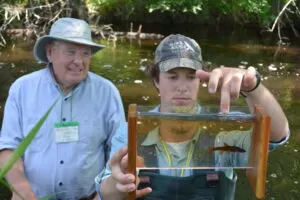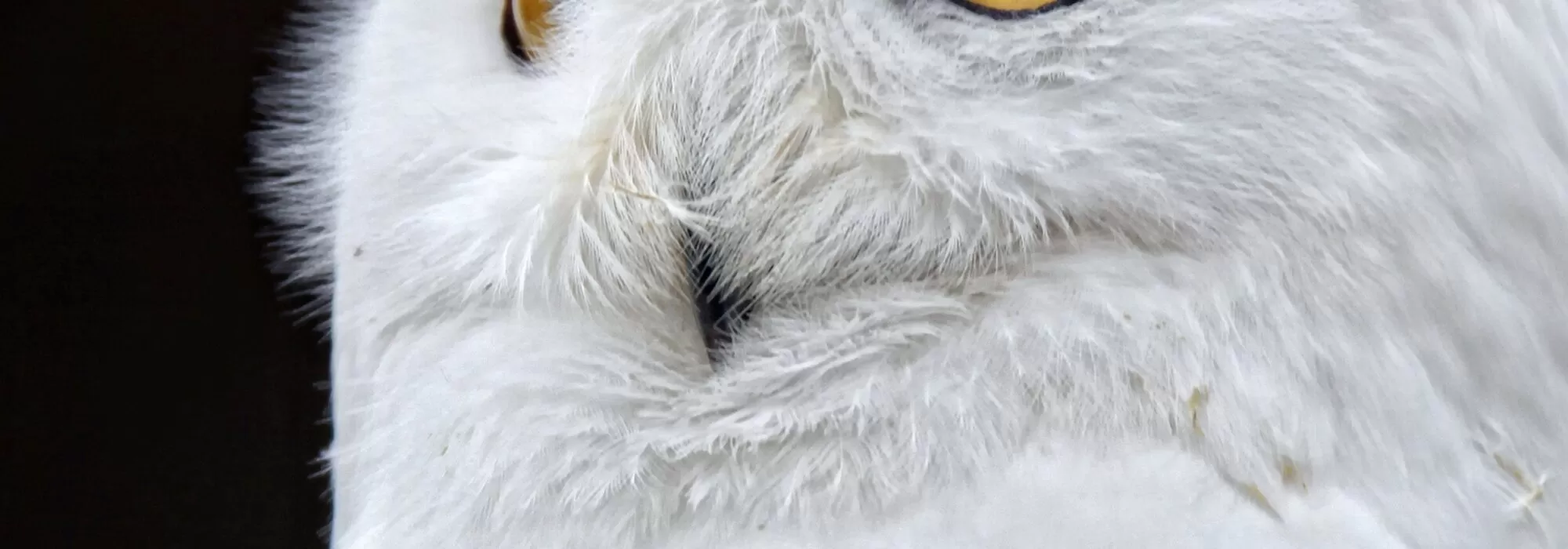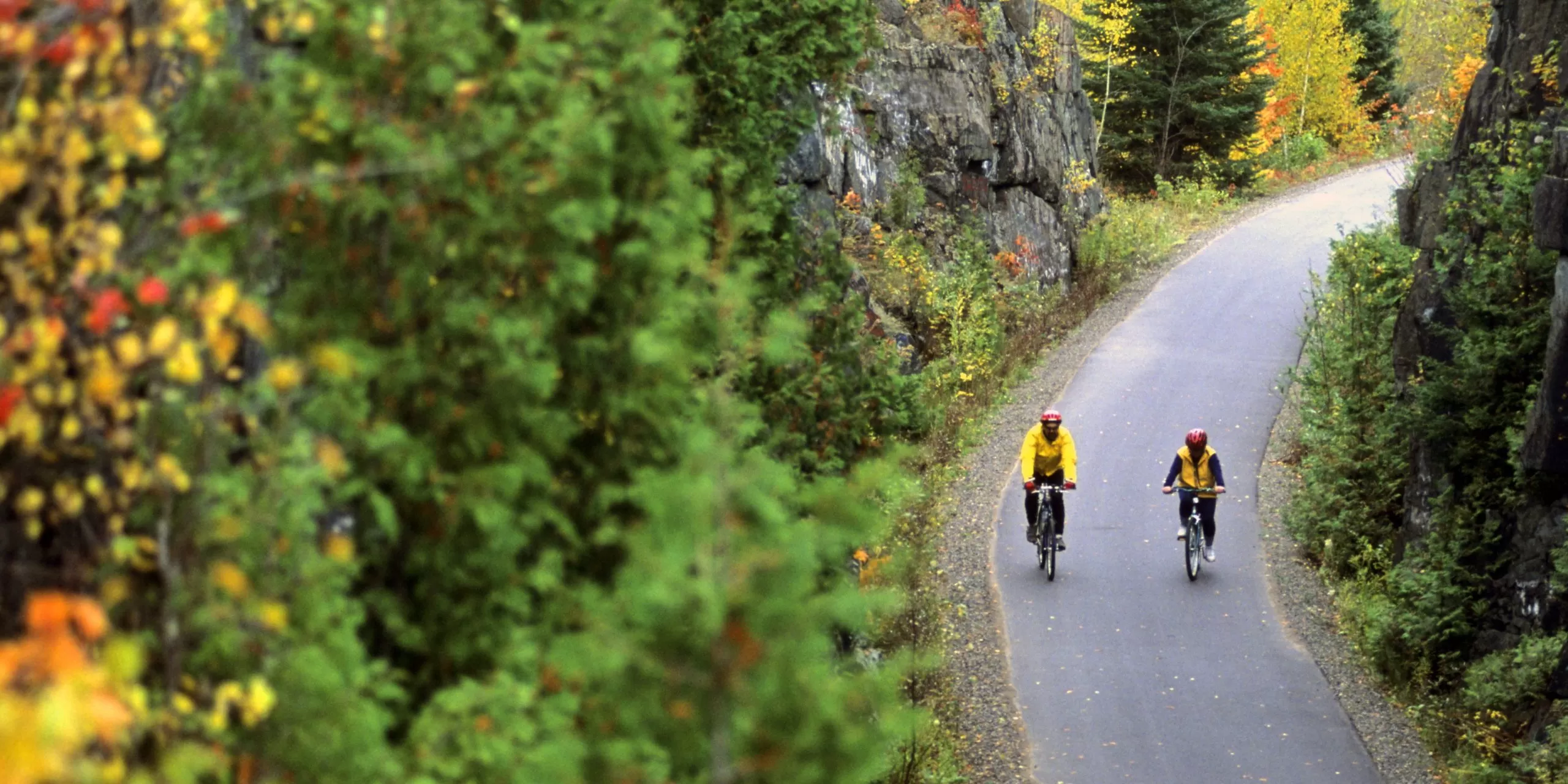Guest Blog: A Vistor’s Guide to the Sax-Zim Bog
Located an easy 50-minute drive northwest of Duluth, Minnesota or equally as nice 40-minute drive south of Virginia, the Sax-Zim Bog is a nationally and internationally known birdwatching location. Knowing this, the “Bog” is relatively unknown to locals and those that frequent northern Minnesota through the seasons. So what actually is the Sax-Zim Bog?
The Sax-Zim Bog is roughly 147,000 acres of not only bog, but aspen uplands, rivers, lakes, meadows, farms and even a couple towns! It was named for the historic towns of Sax and Zim, which no longer exist, though if you talk with the locals you can still find folks who do remember the old towns or who may have even grown up in them.

Head Naturalist Clinton showing BioBlitz participants on shore, and in the water alike (Gene Ollila pictured), a Longnose Dace from a creek in the Sax-Zim Bog. Submitted by Clinton Nienhaus
The Sax-Zim Bog is not just a
mix of habitats, but a mix of land use. A good chunk of the 147,000 acres is public, including properties owned by the Friends of Sax-Zim Bog, the Zim, Sax, and Fermoy Wildlife Management Areas, and a fair portion of the Whiteface River State Forest. The Sax-Zim Bog is not owned by any one entity; rather, it is a mosaic of public and private lands sprawling across the landscape. The Friends of Sax-Zim Bog have the distinction of being a non-profit organization which does much to educate about and preserve the Sax-Zim Bog IBA and even have a Welcome Center, which is open to visitors during the winter season. The Friends of Sax-Zim Bog offer field trips and programs year round. Visit their website here: http://saxzim.org/.

Great Gray Owl: one of the main species visitors come to find in the Sax-Zim Bog, both in the winter and spring. Submitted by Clinton Nienhaus
Just as land use is diverse, so is the wildlife. Many people come to the Sax-Zim Bog to bird watch during the winter, but spring and summer offers a chance at great bird watching, as well. The Sax-Zim Bog is recognized as an Important Bird Area (IBA) due to a set of criteria
established by National Audubon and BirdLife International. An IBA is established if the location in question has species with conservation needs, species in need of specific habitats, or an important site for migration. The Sax-Zim Bog was listed as an IBA due to a few species with specific habitat or conservation needs. These species, Yellow Rail, Great Gray Owl, Sharp-tailed Grouse, American Bittern, and Connecticut Warbler are all species with very different conservation needs and all of which can be found in the Sax-Zim Bogs diverse habitat sets.
But with 300 square miles of habitat to check out, where do you start?
The easiest way to start would be to attend one of the many field trips or education programs offered during the seasons.

Head Naturalist Clinton leading a group on a winter snowshoe hike into the Sax-Zim Bog. Submitted by Clinton NienhausCurrently, the Friends of Sax-Zim Bog website lists the current
Spring and Summer Education Programs and Field Trips. To find the full list, follow this link:
http://saxzim.org/events/. While on these programs or field trips, expect to see a little bit of everything! Though a program may have a specific target, like lichens or butterflies, you can bet
other species will be observed and talked about. Much of the spring and summer programming allows visitors to have a direct experience in the bogs, meaning mud boots and bug spray are not optional!
Crrently, access is getting easier as the Warren Nelson Bog has a boardwalk that is being built. Outside of getting in to bogs, much of the travel around the Bog involves driving from place to place, whether that means looking for birds, plants, or bugs. Hiking is hard to come by, however, there are options for a hike in the Cotton School Forest, which can be found on the Sax-Zim Bog Birding Map, just east of Cotton, MN.
If programs and field trips are not quite what you are looking for, the Friends of Sax-Zim Bog offer guide services for birdwatchers in the winter, spring, and summer. If guided bird watching tours are not of interest, do check out the website for further information, including a driving map which will give you a good route to bird watch in the winter seasons, but can be applied to the summer to a degree.
The easiest way to get around the Sax-Zim Bog is to visit a few times,
with plenty of time for exploring! Each habitat type offers chances to see different species of bird, plant, dragonfly, butterfly, lichen, tree… you name it!

Evening Grosbeak from Mary Lou’s Feeders. Evening Grosbeaks are a bright spot in the cold winter season in the Sax-Zim Bog. Submitted by Clinton Nienhaus
The best time to visit depends on what you are interested in, as there are very distinct seasons and species to find. For the winter specialties, such as Common Redpoll, Pine Grosbeak, Northern Shrike, Rough-legged Hawk, Northern Hawk Owl, or crossbills, mid-December through late February or early March would be best. Migrant warblers move through the bog in the second half of May. Breeding birds are in full song during June and even first week in July. The breeding species of interest including Black-backed Woodpecker, Boreal Chickadee, Great
Gray Owl, Gray Jay, and Sharp-tailed Grouse, can be found all year round, but easiest to find in the winter. However, with enough time spent, you could find all of these species in the summer as well.
With any further questions about visiting the Sax-Zim Bog, feel free to contact info@saxzim.org or naturalist@saxzim.org. If you are interested in learning more about the species diversity that can be found in the Sax-Zim Bog, stayed tuned for another blog post looking at just that!
— Clinton Nienhaus, Friends of Sax-Zim Bog Head Naturalist




